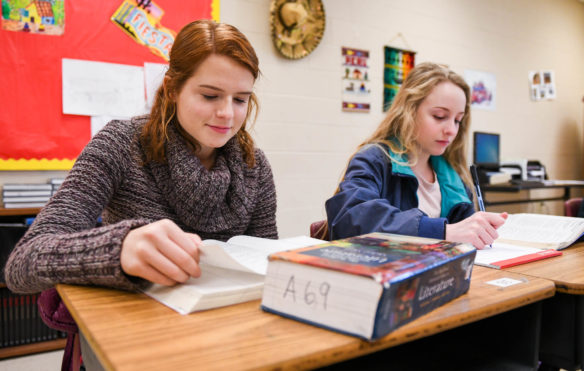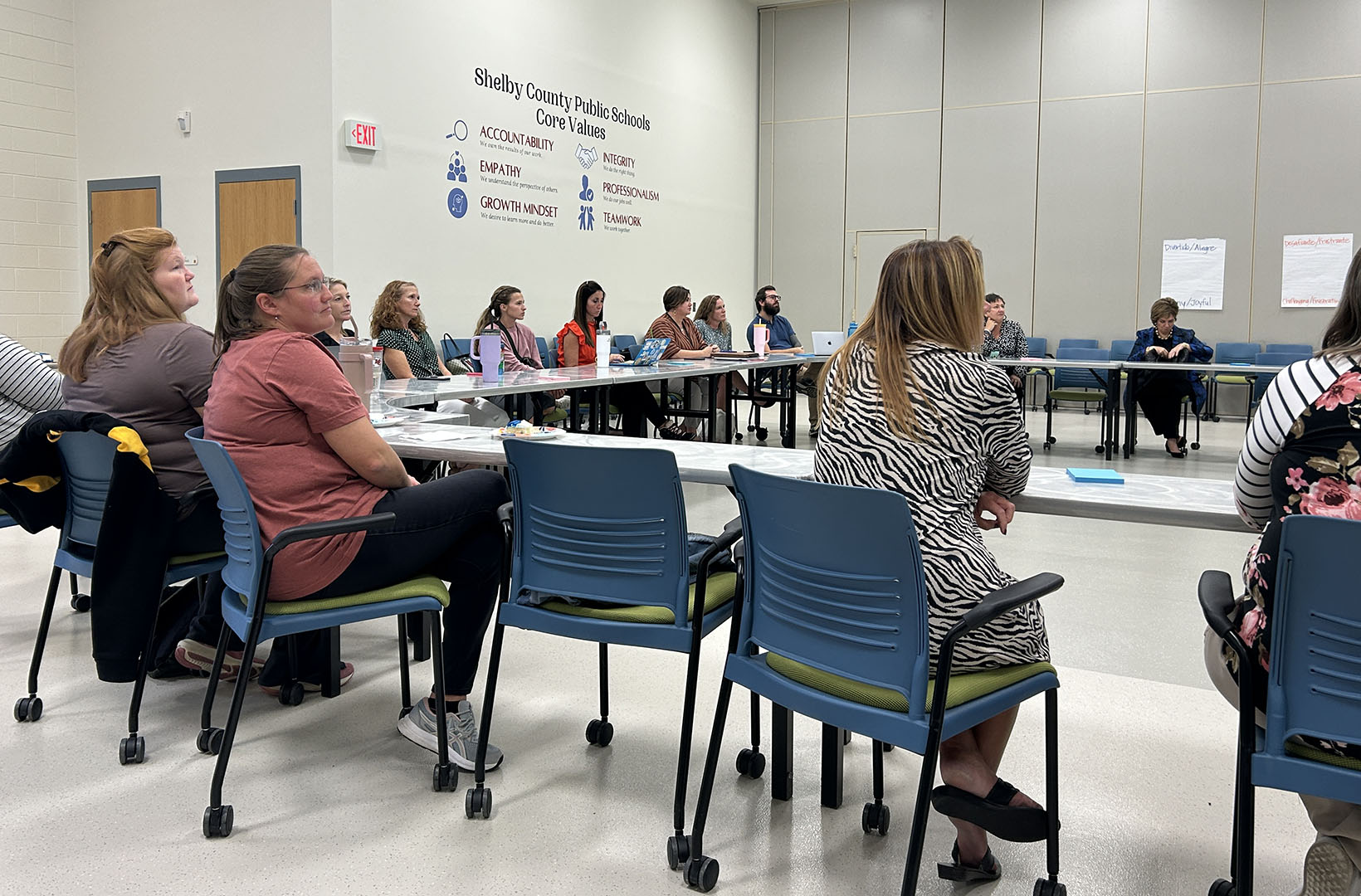
Cassie Hacker, left, and Kate Garad, seniors at Bryan Station High School (Fayette County), review for a test in Laura DeVettori’s Spanish immersion AP literature class.
Photo by Bobby Ellis, Dec. 7, 2017
By Jacque Van Houten and Laura Roché Youngworth
According to the Center for Advanced Research on Language Acquisition (CARLA), language immersion provides a way to learn academic content while acquiring another language at the same time.
In an immersion program, students receive math, science and social studies instruction in a target language, such as Spanish. The teaching strategies used support students in learning the concepts and skills for the subject area, as well as developing the ability to read, write, speak and listen in another target language.
There are two types of language immersion programs:
- One-way: This type of program serves a student population that consists of a majority of English language speakers with limited to no proficiency in the immersion language (e.g., English speakers in U.S. schools).
- Two-way (usually called dual language immersion): This program serves a student population that consists of a majority of speakers of the targeted language of immersion, and a minority of language speakers with dominance in their first language and home language support for this language (e.g., Spanish dominant students whose parents use primarily Spanish in the home and English dominant students from English-speaking homes).
Currently only two Kentucky public school districts offer language immersion programs – Jefferson and Fayette counties.
Jefferson County Public School district’s 2020 Vision
Preparing students with the skills, capacities and dispositions to be successful in college, career and the global community is part of the Jefferson County Public School (JCPS) district’s 2020 Vision. Reaching that goal involves mastering core academic standards, learning to be effective communicators in English and a world language, and developing cognitive and metacognitive skills – all through deeper learning.
One route JCPS is taking to make that happen is through dual language immersion programs. Until last year, JCPS only had one immersion program. Now, there are two elementary programs and one in a planning stage, one middle school program and plans for continuation in a high school.
Hawthorne Elementary School offers a one-way, 50-50 – this number refers to the amount of school day in which a specific subject area is taught through the second language – schoolwide Spanish immersion program. Kindergarten through 5th-grade students spend half of their instructional day immersed in Spanish (math, science, Spanish literacy and the arts) and half of their day in English (English language arts, social studies and other related arts). The school hosts an annual Spanish spelling bee, partners with an Ecuadorian theater group and offers a travel opportunity to Puerto Rico so parents, students and teachers can visit a partner school.
In recent years, Hawthorne has consistently met academic goals and developed high Spanish language proficiency in students. In the past two years, 61 rising 6th-graders earned from one to three high school performance-based world language credits as a result of their performance on the America Council on the Teaching of Foreign Languages’ (ACTFL) Assessment of Performance toward Proficiency in Languages (AAPPL). Twelve of the 61 students scored at intermediate mid 3 or higher.
The AAPPL is an online test that measures students’ performance across three modes of communication: interpersonal listening/speaking, presentational writing, and interpretive listening and reading.
Last year, JCPS opened a second Spanish immersion program at Goldsmith, an international and cultural studies magnet elementary school. Principal Jeremy Renner spent a year learning and working with his faculty and parents of existing and incoming kindergarteners to get their buy-in. Such programs grow one grade at a time, which allows for immersion teachers to be hired and target language materials to be bought or developed in increments.
Renner started with a strand of one immersion class per grade rather than the full-school model, and because of the high number of Hispanic students, implemented a 50-50, two-way dual language program. In two-way programs, English learners (native speakers of the target language) comprise at least 33 percent of the classroom and English-only students (native English-speakers) comprise at least another 33 percent of the classroom.
According to research, immersion programs are an effective intervention model for narrowing the achievement gap between high- and low-performing populations, especially English learners, partially as a result of the cognitive demands experienced by students who learn in two different languages.
In order to offer a continuation of the elementary immersion experience, Principal Tom Aberli – who is serving as interim principal for two years – created a new immersion strand at Highland Middle School this year, where science is being taught in Spanish. In the 2020-21 school year, when Aberli returns as principal at Atherton High School, he will initiate an immersion strand there, thus completing the K-12 articulation.
As programs grow and more data is gathered on closing achievement gaps, JCPS will be looking at whether to increase immersion offerings in other schools and other languages. The large Spanish-speaking population, active Chinese community, and French and German heritage of Louisville – as well as international economic interests – will be all areas of influence in such decisions.
Preparing students for a global tomorrow in Fayette County
In 1990, Fayette County Public Schools (FCPS) created an educational opportunity to globally prepare learners in a unique way: the Spanish immersion program. The FCPS language immersion program now has more than 1,500 students and an articulated, K-12 pathway encompassing four elementary schools, a middle school and a high school.
The FCPS language immersion programs include:
- Maxwell Elementary, grades K-5, is a schoolwide program, with every student at the school being a participant. It is a one-way program, with most students being English speakers. Students spend half the day in Spanish and half the day in English, with math, science, social studies (upper grades), and exploratory courses such as Spanish culture, music and technology in Spanish.
- Liberty Elementary, grades K-5, has a strand within the school and is a one-way program with most students being English speakers. Students spend a half day in Spanish and a half day in English, with math and science in Spanish.
- Northern Elementary, grades K-5, has a strand within the school. It is a one-way program with most students being English speakers. Students spend half the day in Spanish and half the day in English, with math and science in Spanish.
- Cardinal Valley Elementary, grades K-3 (4th and 5th grade will be added over the next two years), has a strand within the school. It is a one-way program with all heritage Spanish speakers, 50/50 (rotating schedule of one day in Spanish, one day in English) with both language arts and math being taught in both languages.
- Bryan Station Middle School, grades 6-8, has a strand within the school. It is a one-way program, with most students being English speakers, 50/50 (half day in Spanish and half day in English) with math, language arts/Spanish language, science and social studies being taught in Spanish.
- Bryan Station High School, grades 9-12, has a strand within the school. It is a one-way program, with most students being English speakers. Thirty percent of the day is taught in Spanish and 70 percent is taught in English. Spanish language and AP Spanish and literature, biology, chemistry, physics, geometry/algebra, and literature and film are taught in Spanish.
With each successive year, FCPS has been fine-tuning the overall experience and abilities of its immersion learners. Four of the programs have earned certification through the International Spanish Academies after having met rigorous standards set forth by the Spanish Embassy. The district has re-implemented language proficiency testing using the AAPPL assessment at key grade levels to monitor and support language growth. Teachers have numerous opportunities to attend professional learning opportunities at the district, state and national levels focusing on math, cooperative learning and best-practices for the immersion classroom. Guidebooks for teachers and administrators also are being created to inform instructional and programmatic decisions.
And for the district’s graduates, FCPS adopted the Seal of Biliteracy as a form of recognition for any student who can demonstrate high levels of literacy in two or more languages: English and any other world language. In 2017, 100 percent of the immersion graduates earned this distinction.
At the secondary level, two immersion facilitators were added in 2017 to support instructional practices, language growth and student experiences. At Bryan Station High School, the facilitator meets with each student to set language proficiency goals, organizes a wide range of community service opportunities requiring Spanish to be used in real-world situations and organizes an annual trip to Spain. At Bryan Station Middle School, the facilitator coordinates regular tutoring in Spanish, convenes a conversation group to support students’ language and academic skills, and communicates with parents through weekly newsletters and parent nights to further support student learning.
Building an immersion program is a commitment involving time, personnel and funding. For districts considering such an opportunity for their students, we strongly encourage beginning with a site visit. This will allow your district to explore what goals you might have, what model or program might work best, and what resources might be needed. If interested in visiting one of our six programs, please contact Laura Roché Youngworth.
Jacque Van Houten is the Jefferson County Public Schools’ world languages coordinator and a former Kentucky Department of Education world languages consultant. Laura Roché Youngworth is the Fayette County Public Schools’ world languages coordinator.




Leave A Comment